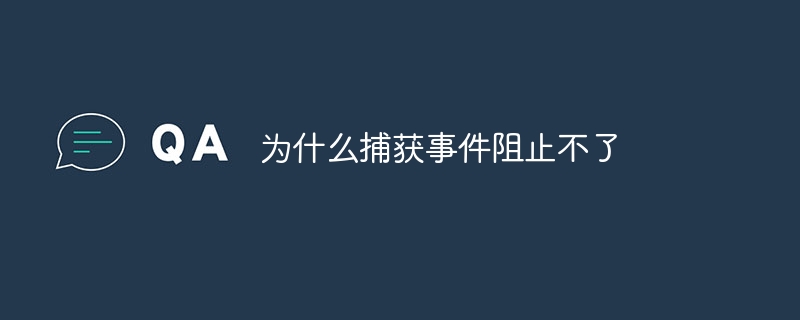
The failure to prevent the captured event may be caused by the execution timing of the event processing function, the binding method of the event processing function, the method of the event object or the event delegation, etc. Detailed introduction: 1. The execution timing of the event processing function. In the event capture phase and the event bubbling phase, the browser will execute the corresponding event processing function in sequence. If you try to prevent the propagation of the event in the event processing function in the event capture phase, but If there is no corresponding processing in the event processing function in the event bubbling stage, the event will continue to bubble; 2. The binding method of the event processing function, etc.

The operating system for this tutorial: Windows 10 system, DELL G3 computer.
In front-end development, event capturing and event bubbling are the two stages of the DOM event model. The event capture phase is propagated downward from the top element until it reaches the target element that triggered the event. The event bubbling phase bubbles up from the target element until it reaches the top-level element. In the process of event propagation, you can control the behavior of the event through some methods in the event handling function, such as preventing the default behavior of the event, preventing the bubbling of the event, etc.
However, sometimes we may encounter situations where we try to capture events and prevent the propagation of events, but find that events still continue to bubble up or cannot completely prevent the propagation of events. This may be due to the following reasons:
1. Execution timing of the event processing function:
During the event capture phase and event bubbling phase, the browser will execute the corresponding event processing function in sequence . If you try to prevent the propagation of the event in the event handler in the event capture phase, but do not perform corresponding processing in the event handler in the event bubbling phase, the event will continue to bubble. Therefore, ensure that the event is handled correctly at all stages to achieve the desired effect.
2. Binding method of event processing function:
When binding event processing function, we can use the addEventListener method to bind the event. This method can receive a Boolean parameter to specify whether the event is triggered in the event capture phase or the event bubbling phase. If not explicitly specified, the default is to trigger the event handler during the event bubbling phase. Therefore, if you want to prevent the propagation of events during the event capture phase, you need to specify the third parameter as true when binding the event handler function.
3. Methods of event objects:
The event object is a parameter passed in the event processing function. It contains event-related information and methods. In the event handling function, we can control the behavior of the event through some methods of the event object. For example, calling the event object's preventDefault method prevents the event's default behavior, but does not prevent the event from bubbling. If you want to prevent the event from bubbling at the same time, you can call the stopPropagation method of the event object.
4. Event Delegation:
Event delegation is a commonly used front-end development technique. It uses event bubbling mechanism by binding event processing functions to parent elements. to handle events on child elements. In event delegation, if you try to prevent the propagation of the event in the event handler, but do not perform corresponding processing on the child element, the event will still continue to bubble up to the parent element. Therefore, when using event delegation, you need to ensure that appropriate processing is performed at all stages of the event to achieve the desired effect.
It should be noted that the propagation and blocking of events are based on the mechanism of the DOM event model, and different browsers may have different implementation methods. Therefore, when writing front-end code, you should try to follow the standard DOM event model and conduct compatibility testing to ensure the consistency and reliability of the code in different browsers.
In summary, in front-end development, event capture and event bubbling are the two stages of the DOM event model. Although we can control the behavior of the event through some methods in the event handler function, sometimes catching the event and preventing the propagation of the event may encounter some problems. This may be due to the execution timing of the event handler function, the binding method of the event handler function, the method of the event object or the event delegate, etc. Therefore, when writing front-end code, you need to carefully consider all aspects of event handling to ensure that event propagation and blocking behavior is as expected.
The above is the detailed content of Why can't capture events be prevented?. For more information, please follow other related articles on the PHP Chinese website!




